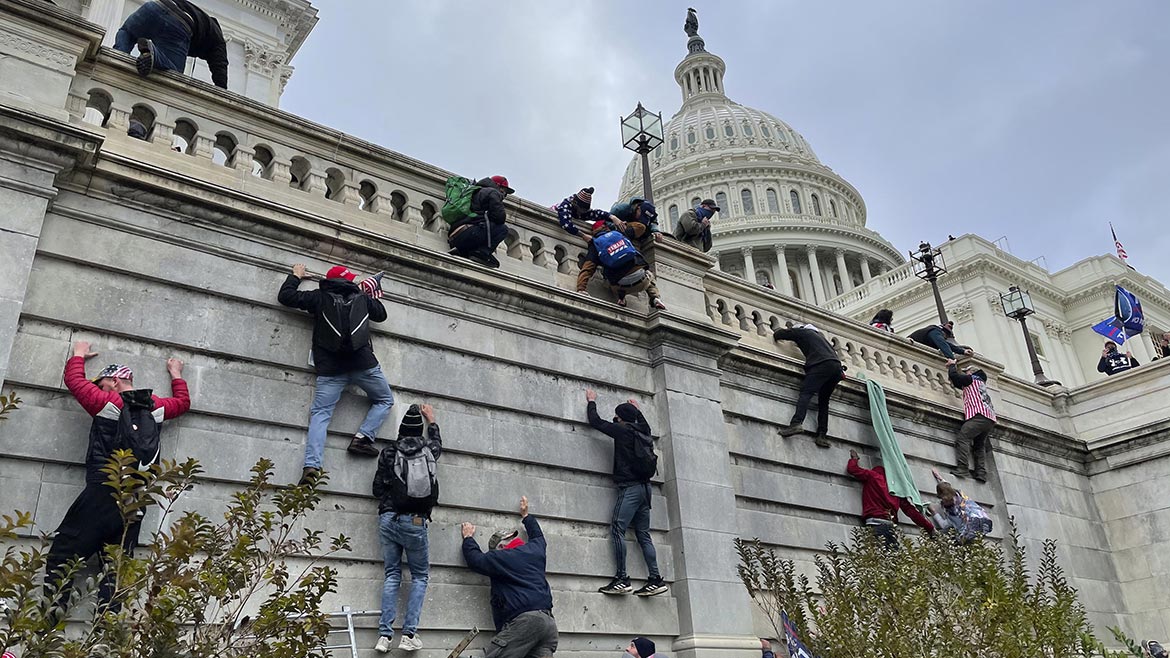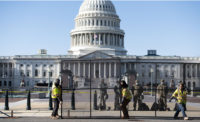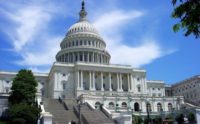Architect of the Capitol J. Brett Blanton says that “significant security improvements” have been made to the U.S. Capitol in the year since the Jan. 6, 2021, deadly riot at the iconic building.
The AOC received $300 million in appropriations for windows and camera systems, Blanton said during a Jan. 4 press conference with U.S. Capitol Police Chief J. Thomas Manger.
Blanton, fielding questions about physical improvements to the Capitol building, noted that the $300-million appropriation was “narrowly focused on windows and cameras.”
Currently under design, the windows are scheduled to be installed in the spring. Blanton says installation is “weather-dependent—you need to have above-freezing temperatures.”
Blanton also said there has been a “significant effort” in reinforcing exterior and interior doors. Damaged windows have been repaired and kiosks have been “upgraded and enhanced.” He said enhanced security lighting and electrical systems have been installed around the Capitol as well.
Manger also testified on Jan. 5 before the Senate Rules Committee.
“January 6 exposed critical deficiencies with operational planning, intelligence, staffing, and equipment,” Manger wrote in prepared remarks released before the hearing. “I recognize those issues have to be addressed, and that is what we are doing. My executive leadership team and I are focused on the transformational change needed to make improvements in those areas.”
Manger said the Capitol Police has expanded its equipment storage facilities, which will help improve equipment deployment strategies.
Security Appropriations
Seven days after Manger was sworn into his post on July 23, 2021, the Emergency Security Supplemental Appropriations Act was signed into law. The measure includes $21.9 million for AOC’s capital construction and operations, including funds to cover AOC spending during the Jan. 6 insurrection.
The legislation does not appear to include specific funding for security vestibules for the Capitol's North and South entrances. Design for the security vestibules was slated to start in April 2021, according to Blanton’s March 11 testimony before a House Appropriations subcommittee hearing on the fiscal 2022 budget request for the AOC's programs.
Those checkpoints would be in addition to the $600-million Capitol Visitor Center, which opened in 2008.
At the March hearing, Blanton also said his office is working with the U.S. Army Corps of Engineers on a comprehensive security assessment that incorporates “all the other studies that are out there and make sure that we can build it into one cohesive executable strategy.”
Lessons Learned
Thomas Vonier, a Washington, D.C., and Paris-based-architect, told ENR via email that although he cannot comment directly on work completed or underway, his “firm view” is that “the Capitol building itself performed admirably in the assault a year ago."
Vonier who also is the immediate past president of the International Union of Architects and a past president of the American Institute of Architects, added, "The ‘failures’ in that debacle were human (as were some of the successes, on the part of the Capitol Police, the Metropolitan Police Department, and Hill staffers), while the building largely withstood determined attackers and provided safe havens for the mob's targets.”
Peggy Van Eepoel, senior principal in Thornton Tomasetti’s Washington, D.C., office—who oversees the firm’s protective design and security practice—says that “lessons learned, and still being learned,” from Jan. 6, 2021, are invaluable.
Van Eepoel—who has helped design and structurally harden more than 200 buildings, including facilities for the U.S. State Dept., General Services Administration, Dept. of Defense and Dept. of Veterans Affairs—told ENR that those lessons help refine simulations officials conduct to prepare for potential attacks.
This “forensic study of the details of the attack,” she says—including “vulnerabilities exposed, the tactics used and the resulting human and property damage”—help to shape the revision of so-called threat, vulnerability and risk assessments (TVRAs) at the Capitol Complex.
They also play a role in the TVRAs for “other government and private facilities that are proximate or experienced effects of violent protests in 2020/2021,” she says.
Van Eepoel adds that the refined TVRAs help create “holistic security strategies” that include temporary or permanent physical security, such as new fence lines or barriers around a site and technical security, such as facial recognition software, improved visitor surveillance systems or lighting.
She also says that updated TVRAs help update operational security that include emergency response plans.






Post a comment to this article
Report Abusive Comment